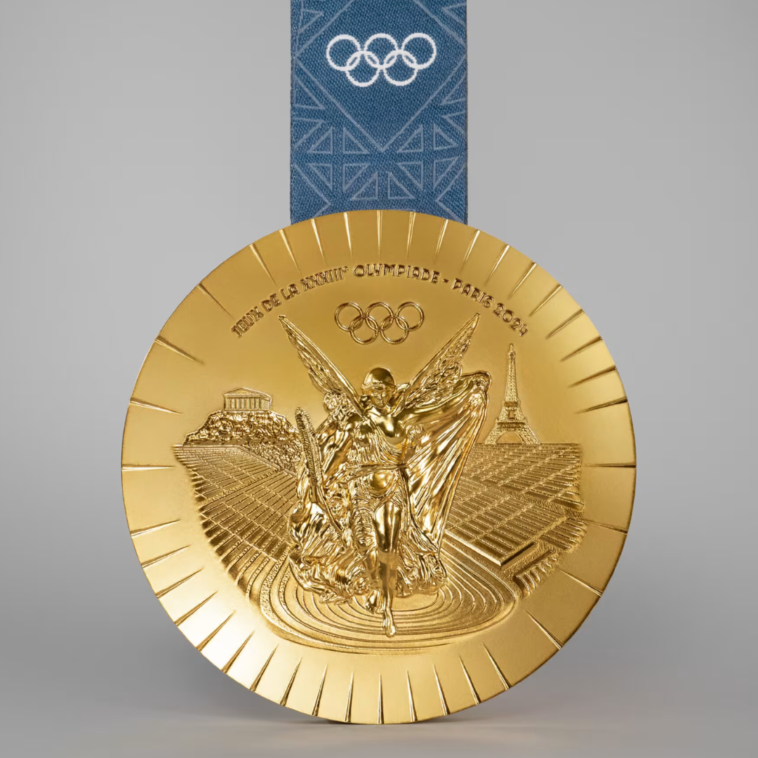The Olympic Games are not only a celebration of athletic prowess but also a testament to human perseverance, dedication, and the spirit of competition. Central to this celebration are the Olympic medals, coveted symbols of victory and achievement. This article delves into the size, materials, and rich symbolism behind these iconic awards.
Size of Olympic Medals
Olympic medals vary slightly in size depending on the host city and the design choices made by the organizing committee. However, there are standard guidelines set by the International Olympic Committee (IOC) that ensure a degree of consistency.
Generally, Olympic medals have the following dimensions:
– Diameter: Approximately 85 to 90 millimeters (3.35 to 3.54 inches)
– Thickness:Around 7 to 12 millimeters (0.28 to 0.47 inches)
– Weight: Varies between 500 and 800 grams (1.1 to 1.76 pounds)
These dimensions provide a substantial feel to the medals, reinforcing their significance as prestigious awards.
Composition of Olympic Medals
The composition of Olympic medals is a topic of great interest, as it involves a blend of tradition, symbolism, and sustainability. The three primary types of medals awarded are gold, silver, and bronze, each with unique materials and construction.
Gold Medals
Contrary to popular belief, Olympic gold medals are not made entirely of gold. Since the 1912 Stockholm Olympics, gold medals have been predominantly composed of silver with a gold plating. The specifications typically include:
– Core Material: Sterling silver (92.5% pure silver)
– Gold Plating: At least 6 grams of pure gold (24 karats)
This combination ensures durability while maintaining the luster and prestige associated with gold. The use of a silver core also reflects the cost considerations and practicality of crafting large numbers of medals.
Silver Medals
Silver medals are composed of pure silver. They represent second-place finishes and are crafted with precision to match the quality of gold medals. The composition is generally:
– Material: Sterling silver (92.5% pure silver)
The consistent use of high-purity silver ensures that these medals retain their value and shine, embodying the honor of finishing second in the world’s most prestigious sporting event.
Bronze Medals
Bronze medals, awarded for third-place finishes, are made from a mixture of copper and tin. This alloy, known as bronze, provides the medals with their characteristic reddish-brown hue. The typical composition includes:
– Material: 88% copper and 12% tin
This durable combination symbolizes the enduring spirit of the athletes who reach the podium, showcasing their strength and resilience.
Symbolism and Design
The design of Olympic medals is rich in symbolism and often reflects the culture, history, and values of the host city. The front side of the medals typically features the iconic image of Nike, the Greek goddess of victory, holding a palm in her left hand and a winner’s wreath in her right.
This design is complemented by the official name of the respective games.
Front Side
The image of Nike has become synonymous with the Olympic spirit, representing victory and the celebration of human potential.
This iconic imagery connects modern athletes with the ancient origins of the Olympic Games, bridging history and contemporary achievements.
Reverse Side
The reverse side is where host cities get creative, showcasing elements unique to their heritage and the Olympic spirit. For example, the Tokyo 2020 medals featured a design inspired by Japanese culture, incorporating motifs that represent the energy of athletes and the brilliance of those who support them. This aspect allows each Olympic Games to leave a unique imprint, making each medal a piece of art and a historical artifact.
Production Process
Creating Olympic medals involves meticulous craftsmanship and a deep commitment to quality. The process begins with designing the medal, which often involves a competition among artists and designers. Once the design is finalized, prototypes are created and reviewed for approval.
Minting
The actual production process, known as minting, involves several stages:
- Casting and Stamping:The metal is melted and cast into blanks, which are then stamped with the design under high pressure.
- Polishing: The medals are polished to enhance their appearance and remove any imperfections.
- Plating: For gold medals, the silver core is plated with gold.
- Finishing Touches: Final touches include engraving the event and athlete’s name.
Each medal is meticulously inspected to ensure it meets the highest standards of quality and craftsmanship.
Sustainability and Innovation
In recent years, the IOC and host cities have emphasized sustainability in the production of Olympic medals. For instance, the Tokyo 2020 Olympic medals were made from recycled electronic devices donated by the public. This initiative not only highlighted the importance of recycling but also involved the entire nation in the creation of these prestigious awards.
This approach to sustainability reflects a broader trend in the Olympic movement towards environmental responsibility and community involvement. By turning e-waste into symbols of athletic achievement, the Tokyo 2020 medals underscored the potential for innovative solutions to environmental challenges.
The Emotional and Cultural Impact
Beyond their physical attributes, Olympic medals carry immense emotional and cultural significance. For athletes, these medals represent years of hard work, sacrifice, and the pinnacle of their sporting careers.
The moment an athlete receives a medal is often the culmination of a lifelong dream, filled with profound emotion and national pride.
Pride National Pride
For the host country and the global audience, Olympic medals symbolize the collective spirit and excellence of the competitors. They are a source of inspiration and pride, encouraging future generations to pursue their own athletic dreams.
Historical Significance
Each set of Olympic medals also becomes a part of history, telling the story of the games and the athletes who competed. They serve as lasting reminders of the achievements and the moments that defined each Olympic event.
Olympic medals are more than just awards; they are symbols of hard work, dedication, and the human spirit’s triumph. Their size, composition, and design elements are carefully chosen to reflect the values and aspirations of the Olympic Games. As athletes from around the world strive for excellence, these medals serve as a timeless reminder of their extraordinary achievements.
The ongoing evolution of medal design and production methods highlights the balance between tradition and innovation, ensuring that Olympic medals remain iconic symbols of the highest level of sporting achievement. Whether made from recycled materials or traditional metals, these medals continue to inspire and honor the best athletes in the world.




GIPHY App Key not set. Please check settings